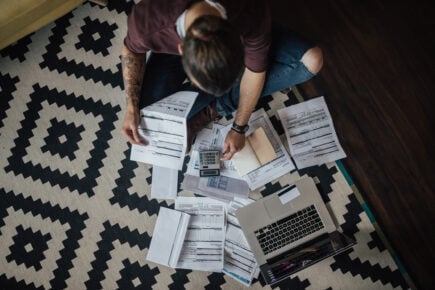You’ve likely heard the terms ‘good’ debt and ‘bad’ debt before, and the difference is important to know before you decide to take on any new debt.
Generally speaking:
- ‘Good’ debt is viewed as the credit you take out that benefits your life. This debt is necessary to take on to create wealth and leverage — a mortgage for a house will build equity, for example.
- ‘Bad’ debt, on the other hand, does the opposite. It’s a burden, a weight on your shoulders. It slows, instead of supporting, your journey to financial freedom — such as a credit card with a 20% interest rate.
A caveat: You can take out ‘good’ debt and lose money. And vice versa, you can use ‘bad’ debt like a credit card and reap the benefits. Knowing the difference usually means taking into account the way the debt is used.
What is ‘good’ debt?
Generally speaking, ‘good’ debt is repaid at a lower interest rate and is designed to increase your net worth or standard of living. It’s more socially acceptable, where even people who are risk averse feel they can comfortably carry ‘good’ debt.
It’s a means to achieve life goals, rather than taking out debt ‘just because’’.
‘Good’ debt is a low-interest loan you can repay over a longer period of time. Because it’s larger, the interest rate is usually more competitive.
Home loan
A mortgage is a path to homeownership, which has long been the most common way to become a millionaire. With one in every five homes across Australia worth more than $1 million[1], owning real estate can be a powerful path to financial freedom.
Most people take out a mortgage to buy a property and then acquire equity, which increases their net worth as their house increases in value. In the past 30 years, the annual growth rate for an average house in Australia has been 6.8%. In the past 40 years, trends for well-located properties in Melbourne, Sydney and Brisbane show homes doubling in value every decade.[2]
- Guideline: Know your numbers and aim to keep your mortgage payment under 30% of your household income.
- Take action: Refinance, move or downsize to make your housing costs more manageable.
Student loan
Education is an investment in your future. By taking out a Higher Education Loan Program (HELP) debt, you receive a degree that increases your future earning potential. Some careers require that you have a university degree to successfully secure a job.
According to the Australian Bureau of Statistics, the higher the qualification, the more likely people are to work full-time.
Culturally, university is a rite of passage for young people and a chapter of life important in and of itself.
- Guideline: Know the percentage you’ll pay based on your income. If you earn between $47,014 and $81,620, expect to pay 1-5% of your taxable income.
- Take action: If you’re an employee, put your annual tax return to your HELP-HECS debt. Create a separate bank account and put 2-5% of every pay into it. Every quarter, make voluntary payments to your HECS debt.
Car loan
Taking out a car lease because you love the new make and model of your favourite brand is not ‘good’ debt. However, investing in a new car to keep you safer is — as long as it doesn’t exceed 20% of your income after tax.
If you drive long distances or are starting a family, having a reliable vehicle is a smart decision. You’ll also reduce the cost of repairs and maintenance. Unlike houses, which appreciate over time, cars lose their value quickly.
Do your research and choose a make and model that holds value well over the years for when you sell it.
- Guideline: Add up all your transport costs, including the car loan. The total cost shouldn’t exceed 20% of your income.
- Take action: Reduce the length of the car loan. You’ll pay more every month but over the life of the loan, minimise the total interest.
Personal loans for some discretionary purchases
Much like a car lease, a personal loan can fall into ‘good’ or ‘bad’ debt. A personal loan can be an option if you need capital to start a business. But if you want to use that money to fund a trip to Europe, that’s a different story. The business is a financial investment. The trip, while undoubtedly life-changing, is a cost.
When deciding what’s ‘good’ vs ‘bad’ debt, think of it in the context of finances.
- Guideline: Personal loans can provide a sizable amount (usually up to $50,000), and the interest rate is usually lower than a standard credit card. NAB offers interest rates starting at 6.99%.
- Take action: Talk to your bank or lender about refinancing or consolidating your debts.
What is ‘bad’ debt?
‘Bad’ debt is burdensome. It’s usually high interest, making it challenging to pay down fast. Unlike a house that appreciates, that European trip you bought on your credit card won’t increase in value.
If it puts financial pressure on your future self without any long-term benefit, it’s likely a ‘bad’ debt.
Payday loans
Small same-day loans are not what they seem. Promoted as a fast, easy way to access up to $2,000, payday loans target those who are in a financial bind. The interest you can end up paying comes close to the loan. For example, to pay back a $2,000 loan over a year, your total repayments will be around $3,360.
One such payday loan lender cited a string of hidden costs — a 20% establishment fee, a 4% monthly fee, and a maximum ‘comparison rate’ as high as 199%.
If you need to access a loan (for emergency needs), look into the No Interest Loans Scheme (NILS).
There are providers that offer loans up to $2,000 for essential goods and services, such as household items, educational materials, some medical expenses, and car repairs. You can find an NILS provider in your state.
- Guideline: Avoid payday loans at all costs. If you can’t pay for a large expense, speak to the provider to discuss your options.
- Take action: Search for NILS providers in your area.
» MORE: 16 Ways to Find Fast Cash
Balances on high-interest credit cards
Credit cards are the perfect example of debt that could be good or bad depending on how it is used.
It’s easy to overpay for purchases once you calculate your credit card interest and the ongoing fees. If you don’t leverage the interest-free period or you’re regularly using the card and not paying attention to the statements, you might not be aware of how much extra you’re spending or how that bloated credit utilisation ratio may affect your credit.
In our instant gratification culture, it’s easy to be persuaded to buy everything now. An entire industry has been created to help us buy what we want right now and pay for it later.
The next time you find something you really want, wait 24 hours. If you feel the same, buy it then. This simple strategy of creating space between your desire and action will support your financial health.
- Guideline: Credit cards can be ‘good’ or ‘bad’. The way you use them determines if they help or hinder your finances.
- Take action: Talk to your bank about the card with the lowest interest and fees. Consider a balance transfer if you’re struggling with debt repayments.
» MORE: How to Get Out of Debt
Article Sources
-
CoreLogic, “One in five Australian homes sold for $1 million or more,” accessed December 20, 2022.
-
Michael Yardney's Property Update, “Do property values really double every 7 to 10 years?,” accessed December 20, 2022.

Ways To Save Money On A Tight Budget
Auditing your expenses and negotiating with lenders and service providers will help you hold on to more money.

How To Get Out Of Debt
Get out of debt by focusing your budget, setting up a repayment plan, reducing expenses, increasing income and saving whatever is left over.

Debt Collectors: What To Do If One Contacts You
A debt collector is a person or company that attempts to recover money owed. Know your rights when it comes to legal debt collection.

Dealing With Debt And Its Impact On Your Financial Health
You know what debt is, but you might not realise its true cost.

